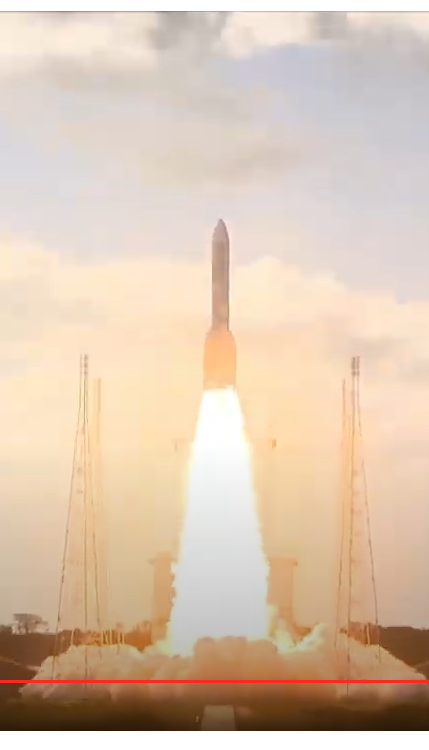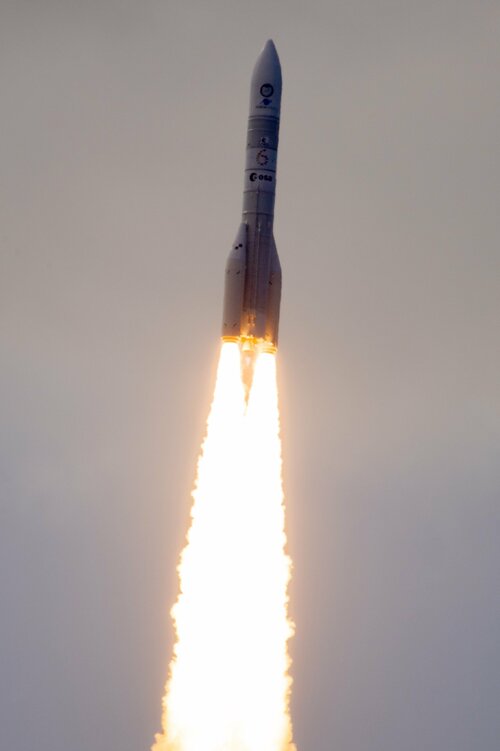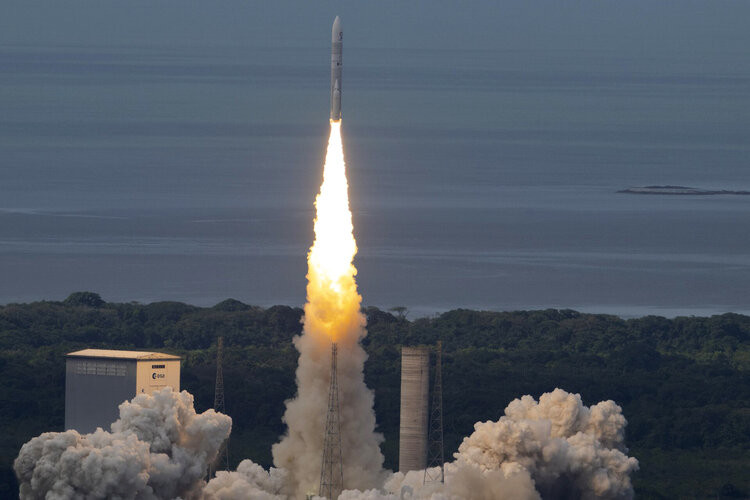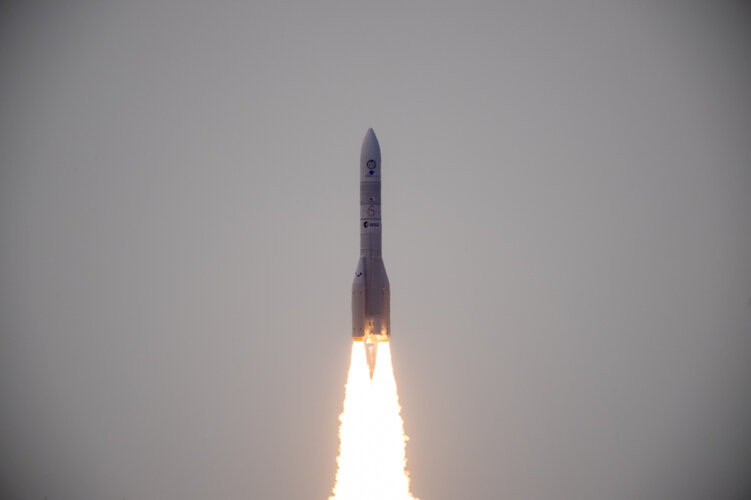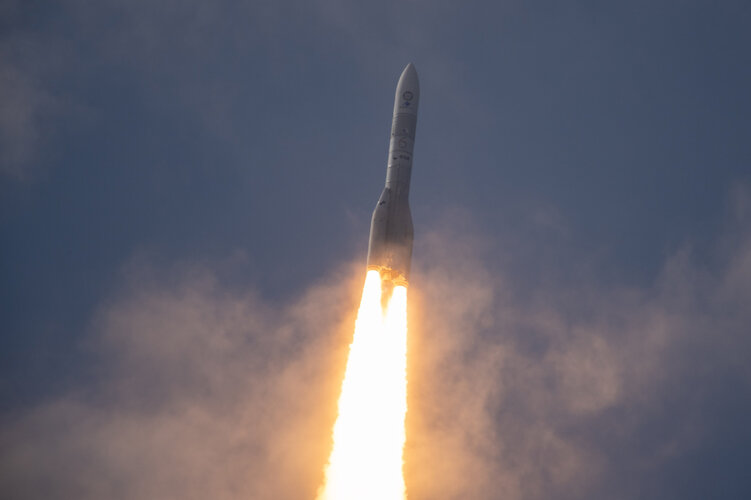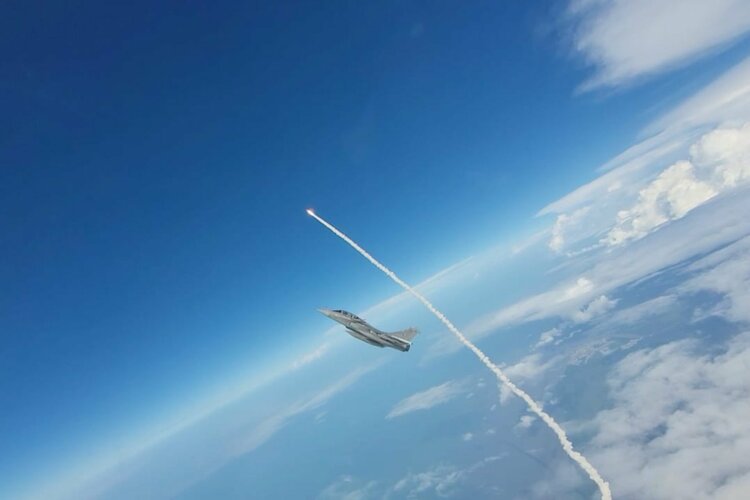You are using an out of date browser. It may not display this or other websites correctly.
You should upgrade or use an alternative browser.
You should upgrade or use an alternative browser.
ESA Ariane 6
- Thread starter Grey Havoc
- Start date
martinbayer
ACCESS: Top Secret
- Joined
- 6 January 2009
- Messages
- 3,343
- Reaction score
- 3,813
In my best understanding, A6 is essentially just a badly facelifted/botched A5 with the fat Italian twin solid rocket booster Mafia corporate interest split into half, i.e. more smaller lipsticks on a pig. That's European pseudo innovation, folks - thanks for watching! I honestly believe Europe should form a serious separate RLV organization outside ESA where any pernicious applicants even trying to push solid or toxic liquid propellants would be automatically disqualified, but that's probably just me...
Last edited:
Ariane 6 is scheduled to launch on 9 July 2024, with a launch window from 15:00-19:00 local time at Europe’s Spaceport in French Guiana (19:00–23:00 BST, 9 July 20:00–10 July 00:00 CEST).
Live WebTV: https://www.esa.int/ESA_Multimedia/ESA_Web_TV
That would be +1 hour from ET, so Launch window in the US would be from 2 to 6pm ET on the 9th of July.

Ariane 6 launch: how to watch and what to look out for
Launch update, 9 July 16:00 CEST: As part of standard operations in the Ariane 6 preparation after mobile gantry removal, routine checks in the ground segment equipment showed a small issue in a data acquisition system. It has now been resolved. Liftoff is now scheduled no earlier than 16:00...
www.esa.int
PS. it´s funny how the popular view summarized by @martinbayer words above has gained traction today. When I wrote similar analysis only days after Ariane 6 was presented, I was the target of so much insults, unjustified hatred comments and Admins (might have been from the Keypub website) censoring that it´s hard to believe and painful to think from how far we came. Had people had better judgment, at least the people in charge, so much money and momentum for Space could have been saved. And industry money doesn´t follow the conservation law: once divested in party drinks, expensive cars, mortgage and failed prenup... It´s lost forever.
Alas, crossing fingers and touching wood for the 6.
Last edited:
martinbayer
ACCESS: Top Secret
- Joined
- 6 January 2009
- Messages
- 3,343
- Reaction score
- 3,813
Don't encourage bad behavior, please, failure where failure is due... The sooner ESA moves onto a true RLV (i.e. Musk style, IDK at this point), the better... Bottom line: LOSE. THE. SOLIDS!Alas, crossing fingers and touching wood for the 6.
Last edited:
TheKutKu
ACCESS: Secret
- Joined
- 13 February 2023
- Messages
- 463
- Reaction score
- 1,379
A launch failure next week would only result in emergency return-to-flight funding (the current A6 program does not have contingency for a failed first launch), which would seriously negatively affect next year's ministerial funding on space transportation, which is supposed to fund the ESA small launcher competition and Cargo return program.Don't encourage bad behavior, please, failure where failure is due... The sooner ESA moves onto a true RLV (i.e. Musk style, IDK at this point), the better... Bottom line: LOSE. THE. SOLIDS!
Also negative impact on psychological/morale/confidence in the european launcher industry-at-large wouldn't make it worth it in any way.
There still needs a few years of maturation of european small launcher companies before they can be trusted with the funding for Medium/heavy launcher that can replace Ariane 6, because none of them have ever launched an orbital rocket (Orbex and RFA are probably the closest), none of them have ever built a large rocket engine, and some of them have serious internal organisation problems (At least PLD Space and RFA from everything I've heard over the years), in the meantime, Space transportation funding will still go to Ariane 6.
Ariane NEXT was a mainly CNES (launcher directorate) concept for the application of the Prometheus engine and the Methalox sector that was decided in ~2016. It is outdated by now, CNES came to the conclusion around 2019 that an intermediary vehicle was needed, and Arianegroup has since managed to impose the smaller Themis/Maia medium launcher architecture (which doesn't threaten Ariane 6, and directly competes with newcomers).Ariane Next looks interesting Michel Van, is there any information about it at this stage or is it too early?
CNES's launcher directorate (or what remains of it) currently seems to be more focused on larger (200-250 tf) engines through the ESA High Thrust Engine program and collaboration with Arianegroup (p10) and The Exploration Company.
This is the kind of general launcher architecture they were thinking of as of 2023:
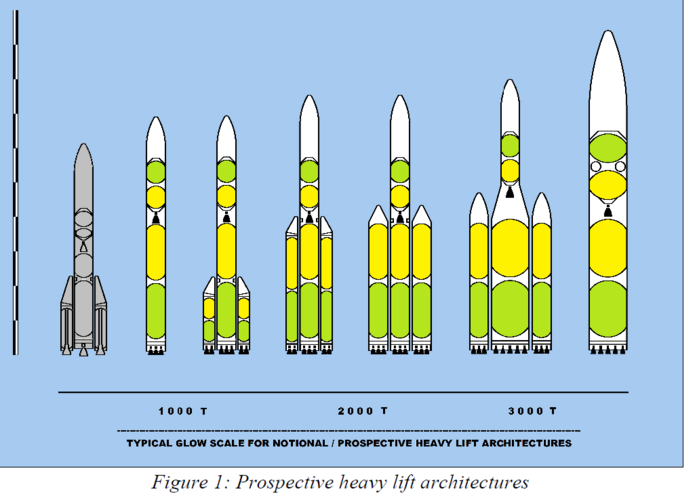
Last edited:
FighterJock
ACCESS: Above Top Secret
- Joined
- 29 October 2007
- Messages
- 5,577
- Reaction score
- 5,896
These designs certainly look impressive TheKutKu, I do wonder though if any of these designs will ever see the light of day or be discarded as being far too complex.
TheKutKu
ACCESS: Secret
- Joined
- 13 February 2023
- Messages
- 463
- Reaction score
- 1,379
View: https://x.com/ESA_transport/status/1810385261160759649
Everything is looking good for the first launch tomorrow.
Everything is looking good for the first launch tomorrow.
FighterJock
ACCESS: Above Top Secret
- Joined
- 29 October 2007
- Messages
- 5,577
- Reaction score
- 5,896
Good luck for Ariane 6's first launch tonight, not long to wait now.
FighterJock
ACCESS: Above Top Secret
- Joined
- 29 October 2007
- Messages
- 5,577
- Reaction score
- 5,896
Watching on ESA Web TV and it was a good Lift off.
- Joined
- 2 January 2006
- Messages
- 3,816
- Reaction score
- 5,014
- Joined
- 13 August 2007
- Messages
- 8,411
- Reaction score
- 10,889
Booster, Core stage work perfect
second stage working well
second stage working well
- Joined
- 13 August 2007
- Messages
- 8,411
- Reaction score
- 10,889
- Joined
- 21 January 2015
- Messages
- 12,096
- Reaction score
- 16,233
FighterJock
ACCESS: Above Top Secret
- Joined
- 29 October 2007
- Messages
- 5,577
- Reaction score
- 5,896
A much more successful first launch than Ariane 5 was.
- Joined
- 13 August 2007
- Messages
- 8,411
- Reaction score
- 10,889
The second stage just circulate its orbit of 580 km
and start deploy the cube sats
after that it will made another orbit, then deorbit burn, drop two reentry capsule on way down
and start deploy the cube sats
after that it will made another orbit, then deorbit burn, drop two reentry capsule on way down
- Joined
- 13 August 2007
- Messages
- 8,411
- Reaction score
- 10,889
the second stage has issue, the vinci engine third ignition was to short
Ground crew look into problem why the engine malfunction and if possible to do fourth ignition for planned deorbit
This failure on Vinci engine can be serious problem for Ariane 6, mean only launch to GTO, but not into GEO with second stage
Ground crew look into problem why the engine malfunction and if possible to do fourth ignition for planned deorbit
This failure on Vinci engine can be serious problem for Ariane 6, mean only launch to GTO, but not into GEO with second stage
Last edited:
and if possible to do fourth ignition for planned deorbit
Hopefully they will be able to do the deorbit burn otherwise the those two RV experiments won't be tested.
TheKutKu
ACCESS: Secret
- Joined
- 13 February 2023
- Messages
- 463
- Reaction score
- 1,379
I'm quite sure the current 2 burns would have been enough for GEO insertion no?the second stage has issue, the vinci engine third ignition was to short
Ground crew look into problem why the engine malfunction and if possible to do fourth ignition for planned deorbit
This failure on Vinci engine can be serious problem for Ariane 6, mean only launch to GTO, but not into GEO with second stage
Anyway, APU was the riskiest technology and faced the most troublesome development, it's not that surprising it doesn't work properly. Hopefully the investigation and correction will be swift and effective.
Succesful orbital launch! Deorbit and "suborbital launch"... not so much.
The next launch is to SSO, the full restart capability may not be needed.
- Joined
- 13 August 2007
- Messages
- 8,411
- Reaction score
- 10,889
status:
Anomaly with the APU. Vinci engine was shut off prematurely.
Video footage show Second Stage is tumbling
View: https://twitter.com/NASASpaceflight/status/1810791963358048360
Anomaly with the APU. Vinci engine was shut off prematurely.
Video footage show Second Stage is tumbling
View: https://twitter.com/NASASpaceflight/status/1810791963358048360
TheKutKu
ACCESS: Secret
- Joined
- 13 February 2023
- Messages
- 463
- Reaction score
- 1,379
2nd stage has been passivated, there won't be any deorbit attempt, the two reentry capsules/suborbital payloads will not be released, one could call that a partial failure if they were pedantic.
Stephane Israel, Arianespace's CEO, says that the APU failure will not delay the next launch, which is planned for december. Next launch won't need Vinci restart so it may indeed be true.
Stephane Israel, Arianespace's CEO, says that the APU failure will not delay the next launch, which is planned for december. Next launch won't need Vinci restart so it may indeed be true.
Last edited:
archipeppe
ACCESS: Top Secret
- Joined
- 18 October 2007
- Messages
- 2,431
- Reaction score
- 3,146
I'd say that the first launch was a qualified success with a successful burn and separation of the SRBs, a successful first-stage burn followed by a successful second-stage separation and initial burn into orbit. I assume by the second-stage being passivated that means its' propellant tanks have been fully blown down to vent the remaining propellant.
bobthemonkey
ACCESS: Restricted
- Joined
- 9 February 2011
- Messages
- 31
- Reaction score
- 89
I believe they said on the webcast that the APU driven restart isn’t needed until they start launching constellations.2nd stage has been passivated, there won't be any deorbit attempt, the two reentry capsules/suborbital payloads will not be released, one could call that a partial failure if they were pedantic.
Stephane Israel, Arianespace's CEO, says that the APU failure will not delay the next launch, which is planned for december. Next launch won't need Vinci restart so it may indeed be true.
On the pretty authoritative https://space.skyrocket.de/doc_lau/ariane-6.htm there are at least 4 launches listed for 2025 that are GTO comsat launches which would corroborate the above, and give them until flight 7 to get it working.
TheKutKu
ACCESS: Secret
- Joined
- 13 February 2023
- Messages
- 463
- Reaction score
- 1,379
Wonderful work!Here it is my contribution...
I believe they said on the webcast that the APU driven restart isn’t needed until they start launching constellations.
On the pretty authoritative https://space.skyrocket.de/doc_lau/ariane-6.htm there are at least 4 launches listed for 2025 that are GTO comsat launches which would corroborate the above, and give them until flight 7 to get it working.
3rd launch should send Galileo, which does require one restart (which they have demonstrated). But yes, the full 3 restarts capability that is yet to be demonstrated is dedicated to constellation launches (with the Astris kick stage as complement)
A much more successful first launch than Ariane 5 was.
That's a pretty low bar. At least this time they didn't penny-pinched a second-hand guidance system from the previous rocket. Nice to see it fly at last !
martinbayer
ACCESS: Top Secret
- Joined
- 6 January 2009
- Messages
- 3,343
- Reaction score
- 3,813
As a passport carrying European, I am somewhat mildly elated at the successful maiden A6 launch, but I am also deeply dismayed at the expendable corner painting/gaslighting going on here. Reusability *is* the future, while solid boosters most certainly aint, and at the snail pace that the ESA/Arianespace bureaucracies are moving, any viable European Musk competitor will most probably well be past my retirement age...
At least this time they didn't penny-pinched a second-hand guidance system from the previous rocket.
It wasn't a second-hand guidance-system that crashed the first Ariane 5 launch it was due to Arianespace engineers wilfully over reusing Ariane 4 guidance and control software, they failed to take into account the massive performance increase of the Ariane 5 over the Ariane 4.
- Joined
- 13 August 2007
- Messages
- 8,411
- Reaction score
- 10,889
seems the second stage had problem before Third Ignition


TheKutKu
ACCESS: Secret
- Joined
- 13 February 2023
- Messages
- 463
- Reaction score
- 1,379
Yes, premature shut down of the 2nd APU burn, the APU provides a few hundred N of thrust to settle propellant and do maneuvers, while pressurising tanks, this prevented the deorbit burn.seems the second stage had problem before Third Ignition

while pressurising tanks, this prevented the deorbit burn.
If the second-stage's propellant tanks have been blown venting all remaining propellant then at its' current orbit it's going to be orbiting for years to come before undergoing an uncontrolled reentry.
Stretching it for them to call this success
That's why I said it was a qualified success.
plus the stuff still attached to it in a 580KM to re-enter in an uncontrolled way at some unspecified later date.
The items of most concern are the two RV payloads as they are designed to survive reentry.
- Joined
- 21 January 2015
- Messages
- 12,096
- Reaction score
- 16,233
I wasn’t referring to anyone on the thread I meant Arianespace calling it a success.That's why I said it was a qualified success.
The items of most concern are the two RV payloads as they are designed to survive reentry.

